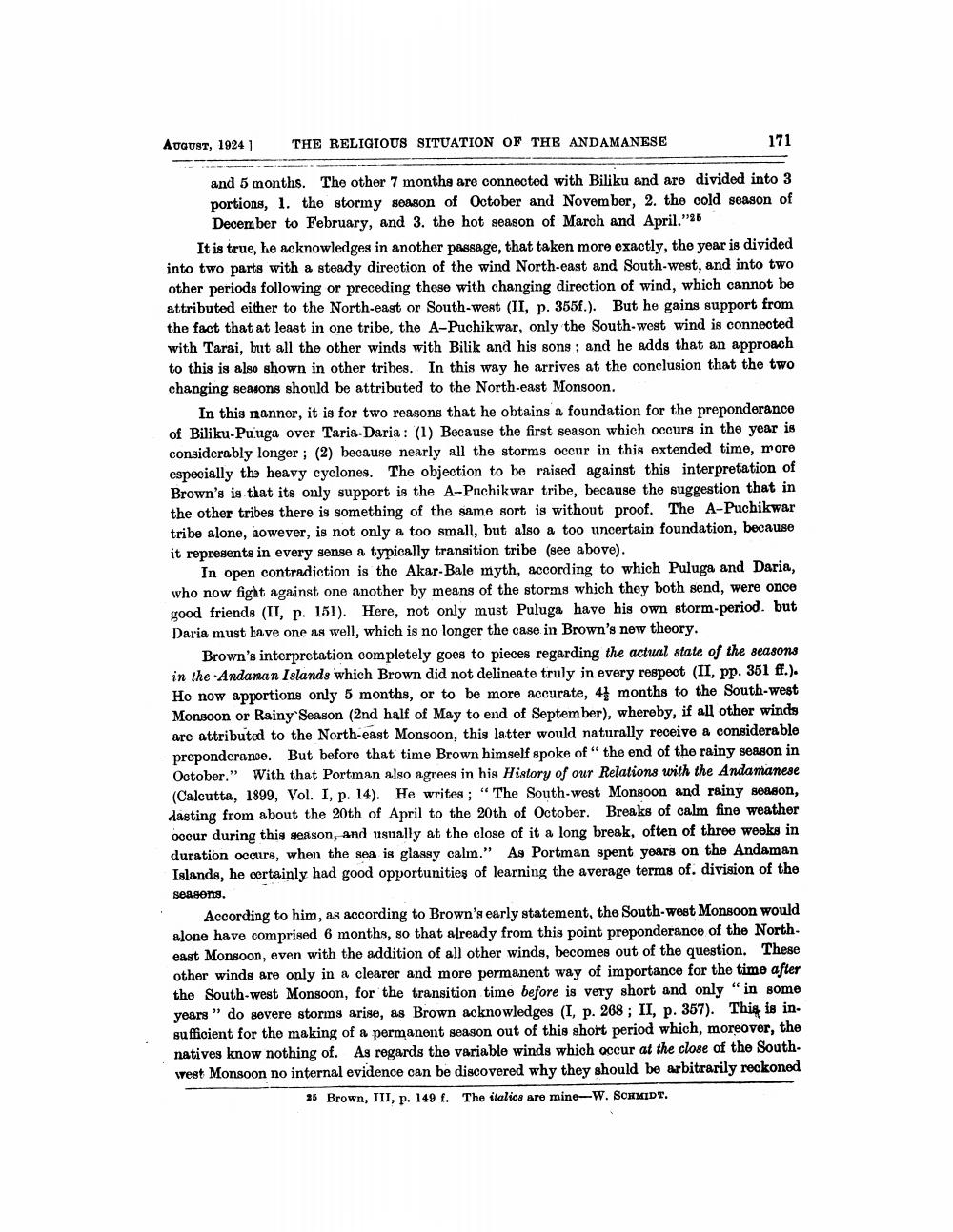________________
August, 1924 ]
THE RELIGIOUS SITUATION OF THE ANDAMANESE
171
and 5 months. The other 7 months are connected with Biliku and are divided into 3 portions, 1. the stormy season of October and November, 2. the cold season of
December to February, and 3. the hot season of March and April."25
It is true, he acknowledges in another passage, that taken more exactly, the year is divided into two parts with a steady direction of the wind North-east and South-west, and into two other periods following or preceding these with changing direction of wind, which cannot be attributed either to the North-east or South-west (II, p. 355f.). But he gains support from the fact that at least in one tribe, the A-Puchikwar, only the South-west wind is connected with Tarai, but all the other winds with Bilik and his sons; and he adds that an approach to this is also shown in other tribes. In this way he arrives at the conclusion that the two changing seasons should be attributed to the North-east Monsoon.
In this nanner, it is for two reasons that he obtains a foundation for the preponderance of Biliku-Puuga over Taria-Daria: (1) Because the first season which occurs in the year is considerably longer ; (2) because nearly all the storms occur in this extended time, more especially the heavy cyclones. The objection to be raised against this interpretation of Brown's is that its only support is the A-Puchikwar tribe, because the suggestion that in the other tribes there is something of the same sort is without proof. The A-Puchikwar tribe alone, however, is not only a too small, but also a too uncertain foundation, because it represents in every sense a typically transition tribe (see above).
In open contradiction is the Akar-Bale myth, according to which Puluga and Daria, who now fight against one another by means of the storms which they both send, were once good friends (II, p. 151). Here, not only must Puluga have his own storm-period. but Daria must have one as well, which is no longer the case in Brown's new theory,
Brown's interpretation completely goes to pieces regarding the actual state of the seasons in the Andaman Islands which Brown did not delineate truly in every respect (II, pp. 351 ff.). He now apportions only 5 months, or to be more accurate, 4 months to the South-west Monsoon or Rainy Season 2nd half of May to end of September), whereby, if all other winds are attributed to the North-east Monsoon, this latter would naturally receive a considerable preponderance. But before that time Brown himself spoke of "the end of the rainy season in October." With that Portman also agrees in his History of our Relations with the Andamanese (Calcutta, 1899, Vol. I, p. 14). He writes; "The South-west Monsoon and rainy season, dasting from about the 20th of April to the 20th of October. Breaks of calm fine weather occur during this season, and usually at the close of it a long break, often of three weeks in duration ocairs, when the sea is glassy calm." As Portman spent years on the Andaman Islands, he certainly had good opportunities of learning the average terms of. division of the seasons.
According to him, as according to Brown's early statement, the South-west Monsoon would alone have comprised 6 months, so that already from this point preponderance of the North east Monsoon, even with the addition of all other winds, becomes out of the question. These other winds are only in a clearer and more permanent way of importance for the time after the South-west Monsoon, for the transition time before is very short and only " in some years" do severe storms arise, as Brown acknowledges (I, p. 208; II, p. 357). This is in. sufficient for the making of a permanent season out of this short period which, moreover, the natives know nothing of. As regards the variable winds which occur at the close of the Southwest Monsoon no internal evidence can be discovered why they should be arbitrarily reckoned
25 Brown, III, p. 149 f. The italics are mine-W. SCHMIDT.




